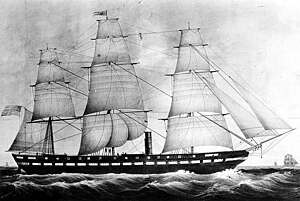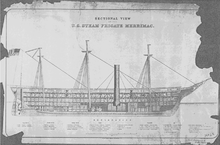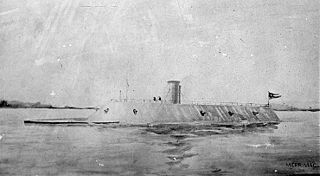
CSS Virginia was the first steam-powered ironclad warship built by the Confederate States Navy during the first year of the American Civil War; she was constructed as a casemate ironclad using the razéed original lower hull and engines of the scuttled steam frigate USS Merrimack. Virginia was one of the participants in the Battle of Hampton Roads, opposing the Union's USS Monitor in March 1862. The battle is chiefly significant in naval history as the first battle between ironclads.

USS Monitor was an ironclad warship built for the Union Navy during the American Civil War and completed in early 1862, the first such ship commissioned by the Navy. Monitor played a central role in the Battle of Hampton Roads on 9 March under the command of Lieutenant John L. Worden, where she fought the casemate ironclad CSS Virginia to a stalemate. The design of the ship was distinguished by its revolving turret, which was designed by American inventor Theodore Timby; it was quickly duplicated and established the monitor class and type of armored warship built for the American Navy over the next several decades.

The Norfolk Naval Shipyard, often called the Norfolk Navy Yard and abbreviated as NNSY, is a U.S. Navy facility in Portsmouth, Virginia, for building, remodeling and repairing the Navy's ships. It is the oldest and largest industrial facility that belongs to the U.S. Navy as well as the most comprehensive. Located on the Elizabeth River, the yard is just a short distance upriver from its mouth at Hampton Roads.

The third USS Delaware of the United States Navy was a 74-gun ship of the line, named for the state of Delaware.

USS Pennsylvania was a three-decked ship of the line of the United States Navy, rated at 130 guns, and named for the state of Pennsylvania. She was the largest United States sailing warship ever built, the equivalent of a first-rate of the British Royal Navy. Authorized in 1816 and launched in 1837, her only cruise was a single trip from Delaware Bay through Chesapeake Bay to the Norfolk Navy Yard. The ship became a receiving ship, and during the American Civil War was destroyed.

The Battle of Hampton Roads, also referred to as the Battle of the Monitor and Merrimack or the Battle of Ironclads, was a naval battle during the American Civil War.

The first USS Columbia of the United States Navy to be commissioned was a three-masted, wooden-hulled sailing frigate, built at the Washington Navy Yard and carrying 54 guns. Her keel was laid in 1825, but as was typical of much Navy construction during this period, she was not launched until much later, on 9 March 1836.
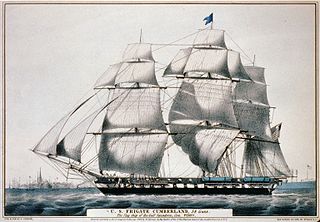
The first USS Cumberland was a 50-gun sailing frigate of the United States Navy. She was the first ship sunk by the ironclad CSS Virginia.

The Confederate States Navy (CSN) was the naval branch of the Confederate States Armed Forces, established by an act of the Confederate States Congress on February 21, 1861. It was responsible for Confederate naval operations during the American Civil War against the United States's Union Navy.

USS Minnesota was a wooden steam frigate in the United States Navy. Launched in 1855 and commissioned eighteen months later, the ship served in east Asia for two years before being decommissioned. She was recommissioned at the outbreak of the American Civil War and returned to service as the flagship of the North Atlantic Blockading Squadron.

USS Congress—the fourth United States Navy ship to carry that name—was a sailing frigate, like her predecessor, USS Congress (1799).

The first USS Pawnee was a sloop-of-war in the United States Navy during the American Civil War. She was named for the Pawnee Indian tribe.
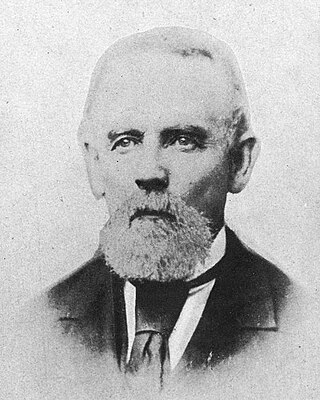
John Luke Porter was a naval constructor for United States Navy and the Confederate States Navy.
USS Plymouth was a sloop-of-war constructed and commissioned just prior to the Mexican–American War. She was heavily gunned, and traveled to Japan as part of Commodore Matthew C. Perry's effort to force Japan to open her ports to international trade. She also served in European and Caribbean waters and, later in her career, she was used to train midshipmen.
USS Germantown was a United States Navy sloop-of-war in commission for various periods between 1847 and 1860. She saw service in the Mexican–American War in 1847–1848 and during peacetime operated in the Caribbean, in the Atlantic Ocean off Africa and South America, and in East Asia. Scuttled at the outbreak of the American Civil War in 1861, she was captured and refloated by the Confederate States of America and placed in service with the Confederate States Navy as the floating battery CSS Germantown before again being scuttled in 1862.
USS Ben Morgan was a schooner acquired by the Union Navy during the American Civil War. She was used by the Union Navy as a hospital ship in support of the Union Navy blockade of Confederate waterways.
USS Yankee was a steam-powered side-wheel tugboat acquired by the Union Navy just prior to the outbreak of the American Civil War.
USS Zouave was a steamer acquired by the Union Navy during the American Civil War. She was needed by the Navy to be part of the fleet of ships to prevent blockade runners from entering ports in the Confederacy.

Drydock Number One is the oldest operational drydock facility in the United States. Located in Norfolk Naval Shipyard in Portsmouth, Virginia, it was put into service in 1834, and has been in service since then. Its history includes the refitting of USS Merrimack, which was modified to be the Confederate Navy ironclad CSS Virginia. It was declared a National Historic Landmark in 1971.

Charles Stewart McCauley was an American naval officer in the War of 1812 and the Civil War.
